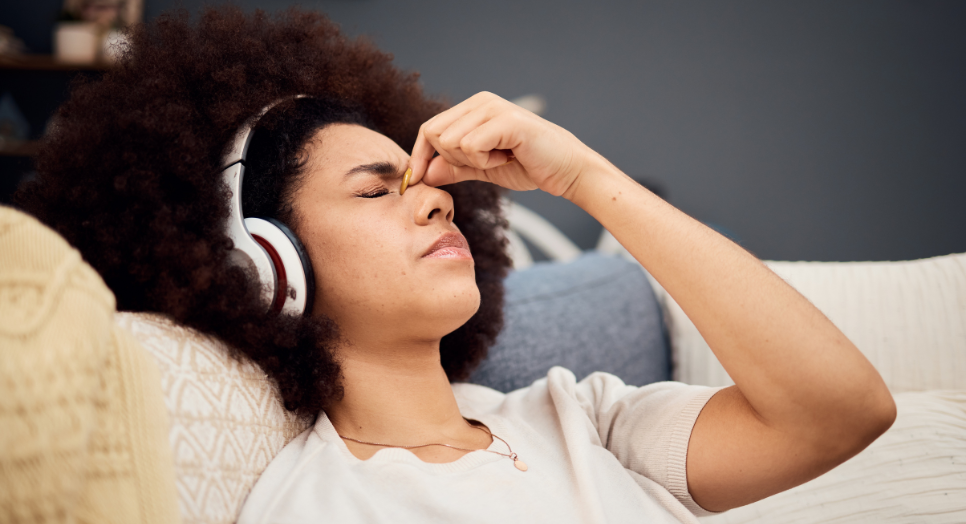Music for Pain Relief

In the hallway of an overcrowded emergency room, I sit uncomfortably on a chair in a makeshift treatment bay, wracked with agonizing pain in the lower left hollow of my back. Nurses and medical staff zip by constantly in both directions and the insistent chimes of alarms sing out discordantly as waves of nausea wash over me.
As I would learn a few hours later, I was suffering from my first (and hopefully last) excruciating experience passing a kidney stone.
I was very lucky that one of my sons was able to come sit with me in the emergency room and keep me company for those painful hours as my kidney stone traveled down through my left ureter. Amazingly, he had thought of bringing me a pair of headphones. I chose some pain relief music that featured solfeggio frequencies at 174 Hz, and immediately, I was transported. The wild hubbub around me melted into insignificance, and I felt my body and mind begin to relax.
Certainly, the IV fluids, anti-nausea meds, and morphine had helped enormously, as well as the powerful effects of the compassion and support of a loved one. However, I was impressed by how soothing and relaxing the healing music for pain relief was—despite the extreme level of pain I had been experiencing—and how completely it took me out of the stressful immediate environment.
Evidence for the effectiveness of pain relief music
A 2023 study at McGill University, published in the journal Frontiers in Pain Research, shows that when it comes to effective pain relief, music can help alleviate pain, especially if it is emotionally moving music. The 63 participants in the study received moderately painful thermal stimuli on the inner forearm for seven minutes, comparable to a hot tea cup being held against the skin, while they listened to musical selections: two favorite musical pieces chosen by the participant, unfamiliar relaxing music chosen for them, scrambled music (which mimics music in every way except its meaningful structure), and silence. They were prompted for assessments of their experience of pain eight times for each piece of music.
The research showed that the participants’ favorite music had a stronger pain-relief effect than unfamiliar relaxing music and that the favorite music that participants categorized as “bittersweet/moving” was the most effective.
How healing music for pain relief works
One of the fascinating elements of the McGill study is that the greatest pain relief occurred when participants reported getting chills while listening to the music.
“We found that reports of moving or bittersweet emotional experiences seem to result in lower ratings of pain unpleasantness, which was driven by more intense enjoyment of the music and more musical chills,” said Darius Valevicius, the author of the paper.
This decreased sensitivity to pain, known as hypoalgesia, can occur when the pain signal is disrupted between the point of input on the body and the recognition of pain by the conscious mind. This study suggests that emotional responses to music have an impact on how effective music for pain relief will be.
“The difference in effect on pain intensity implies two mechanisms—chills may have a physiological sensory-gating effect, blocking ascending pain signals, while pleasantness may affect the emotional value of pain without affecting the sensation, so more at a cognitive-emotional level involving prefrontal brain areas,” said Valevicius.
Healing frequencies
There are many websites and playlists that promote music at 174 Hz as healing music for pain relief and relaxation. Why 174 Hz specifically? That frequency is the lowest frequency on the solfeggio scale, which is a set of 9 electromagnetic tones that are believed by some to be healing frequencies.
During my experience in the emergency room, the 174 Hz pain relief music I found was incredibly soothing, blocking out the stressful noises and chaos around me in the emergency room and allowing me to find a grounded and calm place within myself. If you’re curious about these healing frequencies for pain relief, try listening to some music for pain playlists based on 174 Hz sounds and see what you think.
The science behind selecting music for pain relief
At this time, solid scientific evidence showing the best frequency for pain relief and the efficacy of solfeggio frequencies is lacking; however, we do have a substantial amount of evidence-based knowledge on the best types of music for relaxation and for creating a comforting environment.
The best music to encourage relaxation when you are in pain likely consists of slow and gentle rhythms without too much intensity or variation or perhaps little to no rhythm. The tones in pain relieving music are most often calming, soothing, and abstract, without any sudden high pitches. Music has the ability to elicit a feeling of social connection, which may be especially helpful when the listener is in pain and may be feeling isolated in that experience. As discovered in the pain relief music research noted earlier, familiar music that evokes an emotional response has the potential to stimulate the listener’s reward system most of all.
Read more about music therapy for pain relief and the ways that wellness music can be helpful for relaxation, sleep, meditation, and focus.

 2 min
2 min